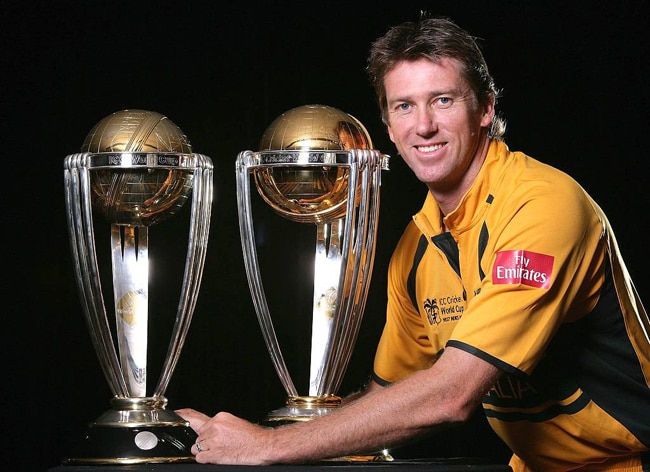
Early Life and Humble Beginnings
Born on February 9, 1970, in Dubbo, New South Wales, Australia, Glenn Donald McGrath came from modest beginnings. Soon after his birth, his family moved to Narromine—a small rural town in NSW—where he began his cricket journey. McGrath’s raw talent on dusty pitches soon caught the eye of former Australian great Doug Walters. Encouraged, McGrath moved to Sydney to further his cricketing ambitions, joining the Sutherland club before making a rapid ascent through the New South Wales ranks. By November 1993, at the age of 23, he had secured his Test debut against New Zealand.
Cricketing Style: Precision Over Pace
McGrath was never known for express pace or unplayable swing. Instead, his career was built on an unwavering commitment to accuracy, relentless discipline, and mental fortitude. Towering at 6’5″ (1.95m), he extracted bounce from even the flattest pitches. His signature? A metronomic consistency of line and length that made him one of the hardest bowlers to score against and the lynchpin of Australia’s bowling attack for over a decade.
Test Career: Redefining Fast Bowling
Glenn McGrath’s stats in Test cricket are nothing short of legendary:
- Matches Played: 124
- Wickets Taken: 563 (highest for any fast bowler at his retirement)
- Bowling Average: 21.64
- Best Bowling in Innings: 8/24
- Five-Wicket Hauls: 29
- Ten-Wicket Matches: 3
A psychological predator on the field, McGrath routinely picked out the opposition’s leading batsman (famously targeting Brian Lara, dismissing him 18 times). His rivalry with the world’s finest, including Sachin Tendulkar (dismissed 13 times by McGrath), was the stuff of cricket folklore.
Australia dominated the Test arena during his stint, winning a stunning 22 out of 30 Ashes Tests he played, and rarely losing at home when McGrath led the attack.
Legendary Spells and Milestones
One of McGrath’s defining moments came at Lord’s in 2005 when he recorded his 500th Test wicket, joining an elite club. His 8/24 against Pakistan at Perth ranks among the greatest Test spells of all time.
Despite being sidelined by injuries or personal hardship, McGrath’s competitive streak never waned. At age 36, in his final Ashes series, he helped Australia regain the urn with a 5–0 whitewash, taking 21 wickets for the series. His last act as a Test cricketer was to bowl Australia’s final ball in the fifth Ashes Test at Sydney in January 2007.
One-Day Dominance: The World Cup Specialist
McGrath’s presence in One Day Internationals (ODIs) was equally impactful:
- ODI Matches: 250
- Wickets: 381
- Bowling Average: 22.02
- Best Bowling: 7/15 (a World Cup record)
- Economy Rate: 3.88
He played a pivotal role in Australia’s golden run, clinching three consecutive World Cups (1999, 2003, and 2007)—a feat matched by just two other players. Remarkably, he finished his career as the highest wicket-taker in World Cup history with 71 wickets, cementing his reputation as an ICC event “big match” player.
At the 2007 World Cup, McGrath was named Player of the Tournament, claiming 26 wickets and helping Australia to another title before retiring from international cricket.
| Format | Matches | Wickets | Average | Best Bowling | 5WI/10WM | Economy Rate |
|---|---|---|---|---|---|---|
| Test | 124 | 563 | 21.64 | 8/24 | 29/3 | 2.5 |
| ODI | 250 | 381 | 22.02 | 7/15 | 7/0 | 3.88 |
| World Cup | 39 | 71 | 18.19 | 7/15 | 2/0 | 3.96 |
Impact on the Game and Teammates
McGrath’s greatest gift to Australian cricket went beyond wickets. His stone-cold temperament and unerring accuracy elevated the performances of his teammates. Legends such as Shane Warne and Brett Lee have credited McGrath’s pressure-building spells with enabling them to run riot at the other end.
Notably, Australia’s win-loss ratios in both Test and ODI cricket dipped significantly whenever McGrath was absent, especially in home matches—a testament to the “McGrath effect.” In the subcontinent, traditionally a graveyard for fast bowlers, McGrath averaged a remarkable 23, proving his adaptability worldwide.
Post-Retirement and Legacy: Giving Back
Upon retiring in 2007 after the World Cup triumph, McGrath’s impact continued off the field. Together with his late wife, Jane, he co-founded the McGrath Foundation, a charity that provides support for breast cancer patients and funds specialist nurses. The initiative, born from Jane’s battle with cancer, has become a major force in cancer awareness and care across Australia.
McGrath also contributed to the game as director of the MRF Pace Foundation in Chennai, nurturing a new generation of fast bowlers and sharing his deep knowledge with aspiring cricketers worldwide.
Accolades and Recognition
- Wisden Cricketer of the Year, 1998
- Allan Border Medal, 2000
- ICC Hall of Fame Inductee, 2013
- Sport Australia Hall of Fame, 2011
- Bradman Awards Honoree, 2012
Cricketing Philosophy
McGrath’s ethos was simple: master the basics, maintain discipline, and out-think the batsman. He demonstrated that raw pace or extravagant swing is secondary to skill, control, and unwavering self-belief. His high-arm action, repeatable rhythm, and calm exterior became a model for bowlers everywhere.
Personal Resilience
Despite his formidable on-field persona, McGrath became widely respected for his humility and resilience. He coped with personal grief openly, turning tragedy into positive action. Throughout all this, he has remained a down-to-earth presence and a beacon for sportsmanship and determination.
Conclusion
Glenn McGrath stands as an immortal figure in cricket history. Not only did he redefine what it meant to be a fast bowler—privileging accuracy, intelligence, and heart—but he shaped the destinies of the Australian team and left a legacy that echoes both on and off the cricket field. His journey from rural New South Wales to the pinnacle of international cricket and his post-cricket philanthropic work ensure the “Pigeon” will forever be revered as a legend of the game and a true hero beyond the boundary.
Various Sources



